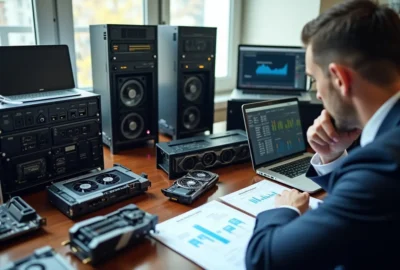Specialized Computing Hardware Investment Guide – Gaming to Enterprise Solutions
The computing hardware market has fragmented dramatically over the past five years. Organizations no longer choose between a “desktop” or “laptop”—instead, they evaluate highly specialized systems optimized for distinct use cases: gaming performance, machine learning inference, scientific computing, real-time rendering, and financial analysis.
This specialization creates both opportunity and complexity. A £3,000 investment in the wrong hardware represents sunk capital and performance disappointment. Conversely, strategic hardware selection can multiply productivity and competitive advantage.
This guide provides frameworks for evaluating specialized computing systems, understanding true cost-of-ownership, and making strategic capital allocation decisions in 2025’s fragmented hardware landscape.
The Hardware Specialization Trend
Why Generalist Devices Are Disappearing
Traditional consumer computing assumed “one device does everything.” Modern reality reflects market maturation:
Specialization drivers:
- Software optimization: Developers build applications for specific hardware architectures
- Performance demands: Video games, machine learning, and rendering require dedicated silicon
- Pricing efficiency: Specialized devices cost 30–50% less than equivalent generalist systems
- Supply chain maturity: Manufacturing at scale reduces specialist hardware pricing
- Competitive pressure: Businesses must adopt optimized tools or lose efficiency vs. competitors
Market segmentation (2025):
- Gaming systems: 15% market share (primarily enthusiast consumers)
- Workstations: 8% market share (content creation, engineering, visualization)
- High-performance compute: 7% market share (AI/ML, scientific, financial)
- General-purpose PCs: 70% market share (declining but still dominant)
Why This Matters for Business
Organizations purchasing “general-purpose” hardware often overpay by 40–60% compared to specialized alternatives. A business running video rendering tasks on a gaming PC instead of a specialized rendering workstation incurs excessive electricity costs, slower project timelines, and reduced competitiveness.
Evaluating Specialized Gaming Hardware
Gaming Hardware Selection Criteria
When evaluating gaming-focused systems for business applications (esports facilities, game development studios, content creation), several factors matter:
Key specifications to assess:
- GPU Performance (TFLOPS)
- Gaming GPUs: 20–100 TFLOPS
- Render capability: 120–240 fps at 4K resolution
- VRAM: 12–24 GB (critical for high-resolution textures)
- CPU-GPU Balance
- GPU-bound workloads: Prioritize GPU over CPU
- CPU-bound tasks: Intel/AMD top processors essential
- Ratio: £800–£1,200 GPU + £400–£800 CPU typical
- Thermal Management
- Ambient operation: Gaming hardware must maintain <80°C under continuous load
- Cooling solutions: Liquid cooling often necessary for professional use
- Noise profile: Important for office environments
- Power Efficiency
- Power supply sizing: 1.5x peak system draw (overhead margin)
- Annual electricity cost: Critical for 24/7 operation
- Example: 500W gaming system at £0.28/kWh = £1,230 annually
For detailed guidance on gaming hardware selection criteria and performance benchmarks, see our comprehensive gaming equipment evaluation guide, which covers GPU specifications, thermal considerations, and long-term reliability factors.
Gaming Hardware ROI for Business
Business application scenarios:
- Game development studio: Gaming-grade GPU clusters accelerate graphics iteration
- Esports venue: Professional gaming hardware ensures consistent competitive performance
- Content creation: Gaming GPUs excel at video rendering and real-time streaming
- 3D visualization: Gaming hardware often outperforms expensive workstations at fraction of cost
Cost analysis (typical game development workstation):
- GPU-focused system: £2,500–£4,000
- Annual electricity: £1,200–£1,800
- 3-year TCO: £6,100–£9,400
- Productivity impact: 30–50% faster rendering vs. CPU-only systems
- ROI: 1–2 years through accelerated project completion
High-Performance Specialized Compute Systems
Enterprise-Grade Computing Hardware
Beyond gaming, specialized compute systems serve distinct enterprise workloads requiring optimized hardware.
Typical high-performance workloads:
- Machine Learning and AI:
- Model training: Requires 100+ TFLOPS of GPU compute
- Inference optimization: Specialized tensor cores accelerate predictions
- Example systems: Nvidia RTX 6000 Ada, professional AI accelerators
- Cost: £8,000–£40,000 per unit
- Annual utility cost: £3,000–£8,000
- Scientific Computing:
- Molecular dynamics simulations
- Climate modeling
- Financial risk analysis
- Requirement: 200+ TFLOPS sustained over 24–48 hour runs
- Power consumption: 800–1,500W continuous
- Real-Time Rendering:
- Autonomous vehicle simulation
- Industrial visualization
- VR content production
- Demand: <16ms frame times (60 fps minimum)
- Multi-GPU systems often required
- High-Throughput Data Processing:
- Data warehouse acceleration
- Real-time analytics
- Time-series database indexing
- Requirement: 300+ GB/s memory bandwidth
High-Performance Hardware Investment Strategy
Capital allocation framework:
| Workload Type | Annual Volume | Recommended Hardware | Investment | Payback |
| Light GPU tasks | <1,000 hours | Gaming-grade GPU | £2,500–£4,000 | 2–3 years |
| ML model training | 2,000–5,000 hours | Professional GPU | £8,000–£20,000 | 1–2 years |
| Continuous compute | 8,000+ hours | Specialized accelerator | £15,000–£50,000 | 1–2 years |
| Multi-node clusters | Distributed workloads | Enterprise systems | £100,000–£500,000+ | 1–3 years |
Advanced Specialized Computing: Purpose-Built Systems
When Standard Hardware Becomes Insufficient
Certain computational requirements exceed the capabilities of consumer and even workstation-class hardware. Organizations pursuing extreme computational optimization examine purpose-built systems engineered for specific algorithms.
System characteristics for extreme optimization:
- Efficiency ratio: Energy consumed per computation executed (measured in joules per terahash or equivalent)
- Thermal density: Power per unit volume (critical for data centre deployment)
- Lifespan: Long-term cost amortization (3–5 years typical)
- Manufacturing optimization: Cutting-edge process nodes (5nm, enabling 50% better power efficiency than previous generation)
Evaluation criteria for specialized compute platforms:
- Process Node Technology
- 5nm systems: 40–50% power reduction vs. 7nm equivalent
- Enables 3–5x better performance-per-watt
- Justifies premium pricing through 3–5 year operation
- Thermal Architecture
- Multi-phase power delivery systems
- Advanced cooling solutions (liquid, passive)
- Temperature management essential for reliability
- Long-term Reliability
- MTBF (Mean Time Between Failures): 50,000+ hours
- Redundancy and failover capability
- Vendor support and replacement parts availability
Organizations researching specialized compute hardware platforms should examine complete product ecosystem documentation, which provides comprehensive technical specifications, thermal requirements, and operational guidelines for purpose-built systems.
For more specific technical analysis of advanced compute systems, the Antminer S21 exemplifies current-generation manufacturing standards: 5nm process technology, integrated thermal management, and efficiency optimization principles directly applicable to enterprise high-performance computing architecture. While designed for specific algorithm optimization, its engineering provides instructive case studies in power delivery systems, heat dissipation, and reliability engineering applicable across specialized computing domains.
Total Cost of Ownership Analysis
Capital vs. Operational Expenses
Three-year TCO breakdown for various systems:
Gaming GPU System (£3,000 base):
- Purchase price: £3,000
- Electricity (3 years): £3,600–£5,400
- Maintenance/parts: £500–£1,000
- 3-year TCO: £7,100–£9,400
- Cost per hour of compute: £0.50–£0.65
Professional Workstation (£15,000 base):
- Purchase price: £15,000
- Electricity (3 years): £8,000–£12,000
- Maintenance/support: £2,000–£5,000
- 3-year TCO: £25,000–£32,000
- Cost per hour of compute: £0.75–£1.15
High-Performance Specialized System (£25,000 base):
- Purchase price: £25,000
- Electricity (3 years): £12,000–£18,000
- Maintenance/support: £3,000–£6,000
- 3-year TCO: £40,000–£49,000
- Cost per hour of compute: £0.85–£1.20
Key insight: Higher upfront investment in optimized hardware reduces per-unit computation cost, provided workload volume justifies the investment.
Decision Framework: Which System Investment Makes Sense?
Evaluation Matrix
Determine appropriate hardware by assessing:
- Annual computation hours required
- <500 hours: General-purpose equipment acceptable
- 500–2,000 hours: Gaming-grade or entry workstation justified
- 2,000–8,000 hours: Professional workstation ROI positive
- 8,000+ hours: Specialized high-performance hardware required
- Computation type specificity
- General-purpose tasks: Flexible hardware choice
- GPU-intensive (rendering, AI): Gaming hardware competitive
- Scientific/specialized: Purpose-built systems optimal
- Real-time constraints: Specialized hardware essential
- Budget constraints
- Limited capital: Begin with gaming-grade systems (30–50% lower cost)
- Moderate budget: Professional workstations (best price-performance)
- High budget: Specialized systems (optimal efficiency)
- Operational environment
- Office environment: Thermal/noise constraints favor premium cooling
- Data centre: Power efficiency dominates ROI calculation
- Remote/mobile: Portability constraints limit options
- Long-term roadmap
- Short-term projects (1–2 years): Depreciation matters less
- Long-term operations (3–5+ years): Specialized hardware amortization improves
- Growth expected: Modular systems enabling expansion preferred
Emerging Trends in Specialized Hardware (2025)
Process Node Advancement
Next-generation hardware continues advancing manufacturing precision:
- 3nm process (2025–2026): 25–30% efficiency improvements expected
- 2nm and beyond (2027+): Incremental gains; physical limits approached
- Alternative architectures: Chiplet designs, 3D stacking emerging
Software-Hardware Co-optimization
Increasingly, software is written for specific hardware architectures:
- AI frameworks: TensorFlow, PyTorch optimized for specific GPU architectures
- Game engines: Unreal Engine 5, Unity increasingly GPU-specific
- Scientific software: Algorithms written for target hardware platforms
The 2025 computing landscape demands strategic hardware evaluation. Generic “best-value” equipment often represents poor investment when specialized alternatives deliver 30–60% better performance per pound spent.
Organizations should evaluate specialized hardware through rigorous TCO analysis: purchase price + electricity + maintenance across expected operational lifetime, divided by computation volume. This analysis frequently reveals that higher upfront investment in optimized systems delivers superior per-unit economics over 3–5 year periods.
For gaming-focused applications, workstation tasks, or specialized high-performance computing, the framework is clear: match hardware specificity to workload characteristics, calculate total cost of ownership accurately, and invest in systems optimized for your particular computational requirements.
The days of “one computer for everything” are finished. Strategic specialization now defines competitive advantage in computing investment decisions.







0